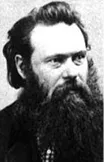The original photos in this book didn't just pop up on our coffee tables. Somebody had to go out in the field and take the pictures, dealing with the smells, the elements and the bugs, using the crude photo equipment of the time. The men who took these photos were pioneers, experimenting with the art and science of taking outdoor photos in the middle of a civil war. Although they strived to give viewers the impression that the photos were taken in the heat of battle (sometimes even using posed scenes), no photos at Gettysburg, or any Civil War battle, were taken while the battle was in progress.
It's helpful to have some background of who these men were and how and when they took their photos. And the two photographers who particularly stand out when it comes to Civil War photography are Alexander Gardner and Matthew Brady.
Alexander Gardner
Although Matthew Brady’s name is synonymous with Civil War photography, many of the more famous photos of Gettysburg - including all of the death photos - were taken by Brady’s nemesis, Alexander Gardner. It was also Gardner who took the famous death scenes a year earlier at the Antietam battlefield. Gardner was also Lincoln's personal photographer, and he took the famous photos of the Lincoln conspirators and their subsequent hanging in 1865.
Gardner once worked for Brady, and it was while in Brady's employment that Gardner took the death scenes at Antietam in September of 1862. These photos shocked the nation and were a tremendous financial success. But it was Brady's studio and the photos went out in his name, with Gardner receiving little or no credit and probably not much of the compensation. No doubt for that reason, in May of 1863, two months before Gettysburg, Gardner established his own studio, in the process luring away two of Brady’s top employees - Timothy O’Sullivan and James Gibson. Unlike Brady, Gardner was careful to give credit to O’Sullivan and Gibson for their photos, which is probably how he convinced them to join his studio.
Brady’s main studio was in New York, 210 miles from Gettysburg, whereas Gardner’s studio was in Washington, just 77 miles from the battle. So upon hearing of a great battle at Gettysburg, Gardner and his crew had a head start.
Based on painstaking analysis by William Frassantino, it appears that Gardner and his associates spent the night of July 4th in Emmitsburg, Maryland, about 10 miles south of Gettysburg. They reached the battlefield about 5pm on July 5th. It would have taken at least an hour or more to set up the photo equipment, so the earliest they could have commenced taking photos was 6 or 6:30pm. Night fell at 7:24pm on that day. So if they did any photography on July 5th, it was minimal.
Therefore, most of the Gardner death-photos were taken on July 6th. By then portions of the Army of the Potomac were already departing Gettysburg, chasing Lee.
Amazingly, three entire days after the battle, Gettysburg residents had not yet discovered the tour-guide business. And so Gardner and his crew probably wandered the battlefield pretty much on their own, getting directions and advice from Federal militia guarding burial details of Confederate prisoners.
The last elements of Lee’s army departed Gettysburg via Hagerstown Road (today, Fairfield Road) on the morning of July 5th. Beginning that day, the Union army collected all loose weapons on the field and then set about burying the dead, starting from the north end of the field and working south. First they buried the Union dead, and then the Confederates. So the last bodies to be buried were Confederates on the southern end of the battlefield.
Given the sensation created by his death photos at Antietam, Gardener was determined to photograph dead soldiers. Fortunately for him, he just happened to approach the battlefield from the south, where the last dead remained unburied.
Bottom-line, all of Gardner’s death scenes had to be taken either late on the 5th or on the 6th, because by the morning of July 7th, the Army of the Potomac had departed Gettysburg, with the burials completed. And, with one possible exception, all the death photos were taken on the south end of the battlefield, specifically around Little Round Top, Devil's Den and Rose Farm.
The one possible exception pertains to some photos of dead Union soldiers in an unknown location, Somehow, somewhere, but most likely as Gardner approached the battlefield up Emmitsburg Road, he happened upon some as yet unburied Union dead, but it's a mystery as to where and when he did so. It's likely the Union dead where the first photos he took on the battlefield. From there, Gardner likely moved on to photograph the Confederate dead south of the Rose farm, and from there he headed over to Devil’s Den.
Probably camping near Devil’s Den on the evening of the 6th, Gardner’s crew was likely put out of action for the next couple of days due to rain and cloudy skies, making outdoor photography difficult or impossible at that time. He next surfaced at East Cemetery Hill, where he was the first of legions of photographers to take the obligatory shot of the Evergreen Cemetery Gate. Probably by then growing antsy to get back to Washington with his precious death scenes, he hung around town long enough to take some rather mundane shots of Gettysburg buildings. But that was it. On the morning of July 9th Gardner and his associates departed for Washington, no doubt intensely pleased to have scooped their former employer, Brady. But in their rush, they skipped taking any photos west or north of town, or of Culp's Hill, the Peach Orchard, the Wheatfield or Cemetery Ridge. Possibly they weren’t aware ...

